If you’ve ever admired those clean, seamless kitchen counters where the sink seems to melt right into the surface, you’ve probably seen an undermount sink. They sit under the countertop instead of on top of it, giving the counter a flat, uninterrupted look. It’s one of those upgrades that instantly makes a kitchen feel more custom and high-end — and the good news is, you can install one yourself if you’re a bit handy.
I’ve helped a few friends install undermount sinks in granite and quartz countertops, and while it takes patience, it’s not rocket science. The key is careful prep, good support, and getting that seal right so it doesn’t leak. Let’s go step by step through the process — the way you’d actually do it in your own home.
Why Choose an Undermount Sink
It’s helpful to know why undermount sinks are so common before getting started.
First, appearances. Everything feels smoother and more open when there isn’t a rim resting on top of the counter. The kitchen appears larger and cleaner because the countertop surface extends all the way to the basin’s edge.
Easy cleaning is the second and most popular reason. Spills or crumbs can be cleaned directly into the sink from the countertop. There is not an edge to catch crumbs or dirt.
Because stone countertops like granite, marble, and quartz can support the weight and hold the sink firmly, undermount sinks frequently look great with them.
What You’ll Need
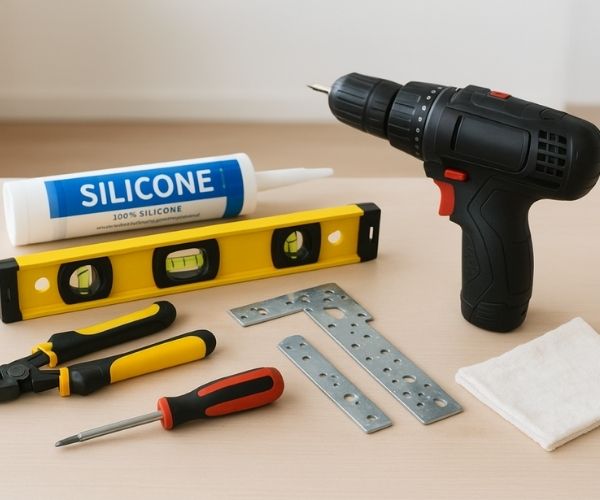
Here’s a simple list of what you’ll want to have before you begin. Some of this might already be in your toolbox:
- Your undermount sink.
- Mounting clips or sink brackets (usually come with the sink).
- Silicone sealant (waterproof, for kitchens/bathrooms).
- Denatured alcohol or rubbing alcohol for cleaning.
- A drill or screwdriver.
- Clamps or support bars (to hold the sink while mounting).
- A level.
- Towels or rags.
- A friend (seriously, it helps!)
Step 1: Get the Countertop Ready
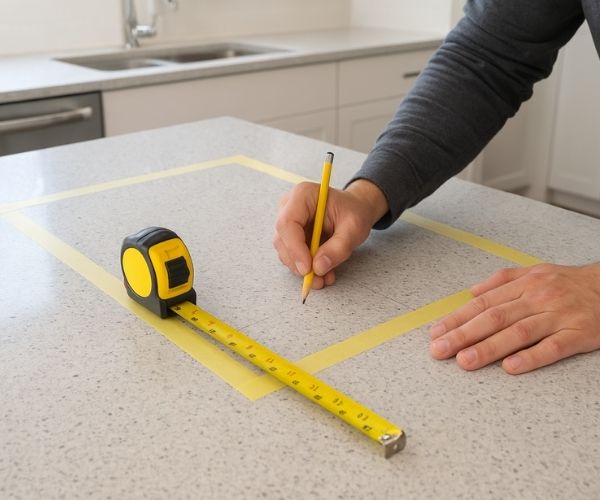
Solid surface materials like marble, granite or quartz are used to install the majority of undermount sinks. In order to replace an old drop-in sink you must first remove it and thoroughly clean the surface.
To get rid of debris, old adhesive or grease, use rubbing alcohol or a mild cleaner. Your seal will be better if your surface is cleaner.
It’s great if your countertop has already been cut to accommodate the new sink. If not it must be precisely cut to fit the dimensions of the sink. Many people have the countertop fabricator handle this, particularly when it comes to stone surfaces.
Step 2: Test Fit the Sink
Test-fit the sink before making any permanent attachments. To make sure it fits securely, and lines up with the edges, place it underneath the countertop cutout.
It should be centered directly beneath the opening. Verify that the plumbing lines, drain and faucet hole line up. A minor change now will prevent a major headache later.
Step 3: Mark and Install Mounting Hardware
The type of sink you have will determine whether you have brackets or mounting clips. These will firmly secure the sink to your countertop’s underside.
Put these brackets where they belong. They are typically placed evenly around the sink, with four or more for larger sinks and two on each side for smaller ones.
Carefully drill pilot holes. You’re just making a place for the clips to grab, so don’t go too deep.
Step 4: Apply Silicone Sealant
The entire job depends on this step.
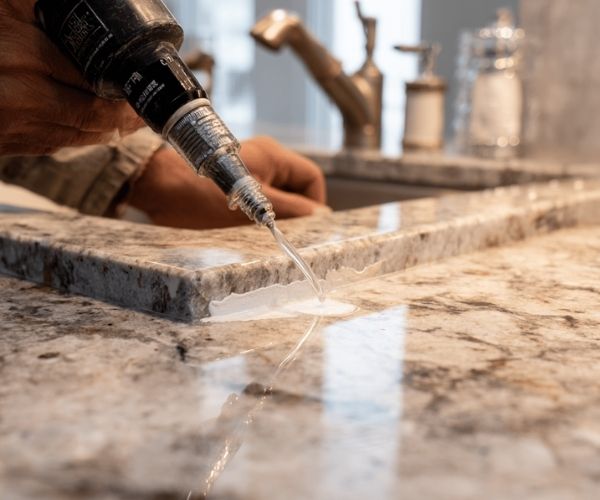
Apply a steady layer of silicone sealant to the countertop cutout’s underside. To create a waterproof seal between the sink and the countertop, you only need to draw a line that is even and smooth, not thick.
Consider it a slow and steady process, similar to frosting the edge of a cake.
Read More: Porcelain Countertops
Step 5: Mount the Sink
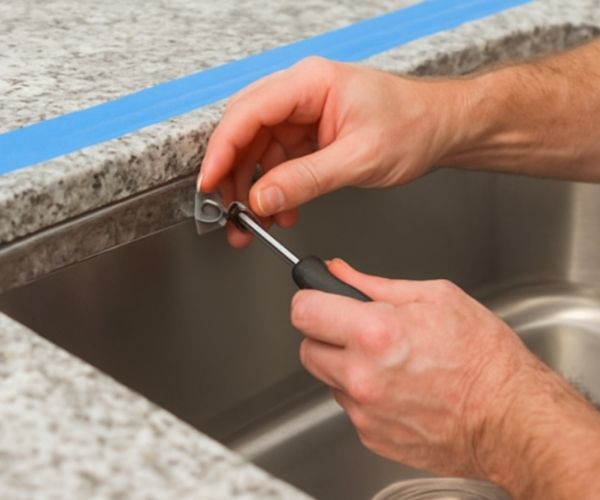
Attaching the sink while maintaining perfect levelness is the difficult part.
This is where having a second person really helps. Lift the sink into position. Firmly but gently press it against the countertop’s underside.
Use your clamps or temporary supports (some people use wood pieces or even a jack stand underneath the sink) to hold it in place while you tighten the brackets or clips.
Make sure the sink isn’t tilted by using a level. Before the sealant sets, make any necessary adjustments.
To allow the silicone to begin curing let it sit for approximately an hour.
Step 6: Tighten Everything Securely
Completely tighten the mounting clips after your sink is positioned correctly, and secured. Just tighten enough to keep the sink in place without breaking anything.
Use a moist rag to remove any excess silicone that drips out around the edges. The line will remain neat, and clean as a result.
Step 7: Install the Faucet and Drain
It’s time to install the faucet, and drain assembly after the sink is securely fastened.
Before reattaching the plumbing do this if your faucet mounts straight into the countertop. Follow the installation instructions provided by the manufacturer for undermount sinks with built-in faucet holes.
Reattach your water lines, attach the drain, and apply plumber’s putty where necessary.
Step 8: Let the Sealant Cure
The majority of silicone sealants require a minimum of 24 hours to fully cure. Do not put weight in the sink, or run water while doing this.
Examine the seal closely once it has dried. You can reinforce it with a tiny bead of silicone if you see any holes or uneven spots.
Read More: Granite vs Quartz
Step 9: Test for Leaks
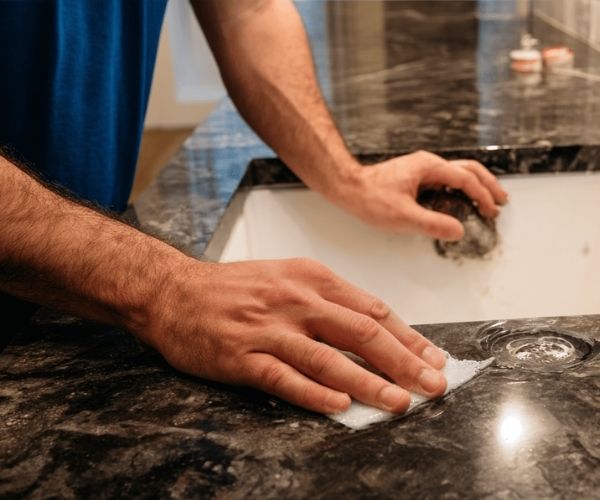
After the sealant has completely dried, fill the sink with water and look underneath for any leaks near the seams or drain. If necessary, tighten the fittings.
Congratulations! You have just installed an undermount sink, if everything appears to be dry and solid.
Tips for a Cleaner, Longer-Lasting Installation
- Use the right sealant: Always pick a high-quality silicone that’s labeled for kitchen or bath use.
- Support heavy sinks: Some large sinks (especially granite or cast iron ones) may need extra support brackets.
- Clean frequently: To avoid mold or discoloration keep the area where the countertop edge meets the sink dry and clean.
- Avoid over-tightening: You want your countertop to fit securely, not to crack under pressure.
Common Mistakes to Avoid
Preventing the dry fit: Always verify alignment before applying sealant.
Using too much silicone: Applying too much silicone can weaken, seal and create mess.
Ignoring support: If you only use clips to hold sink in place while it dries, it may bow slightly.
Not cleaning the counter underside: Any residue, or dust could eventually cause, the seal to break.






